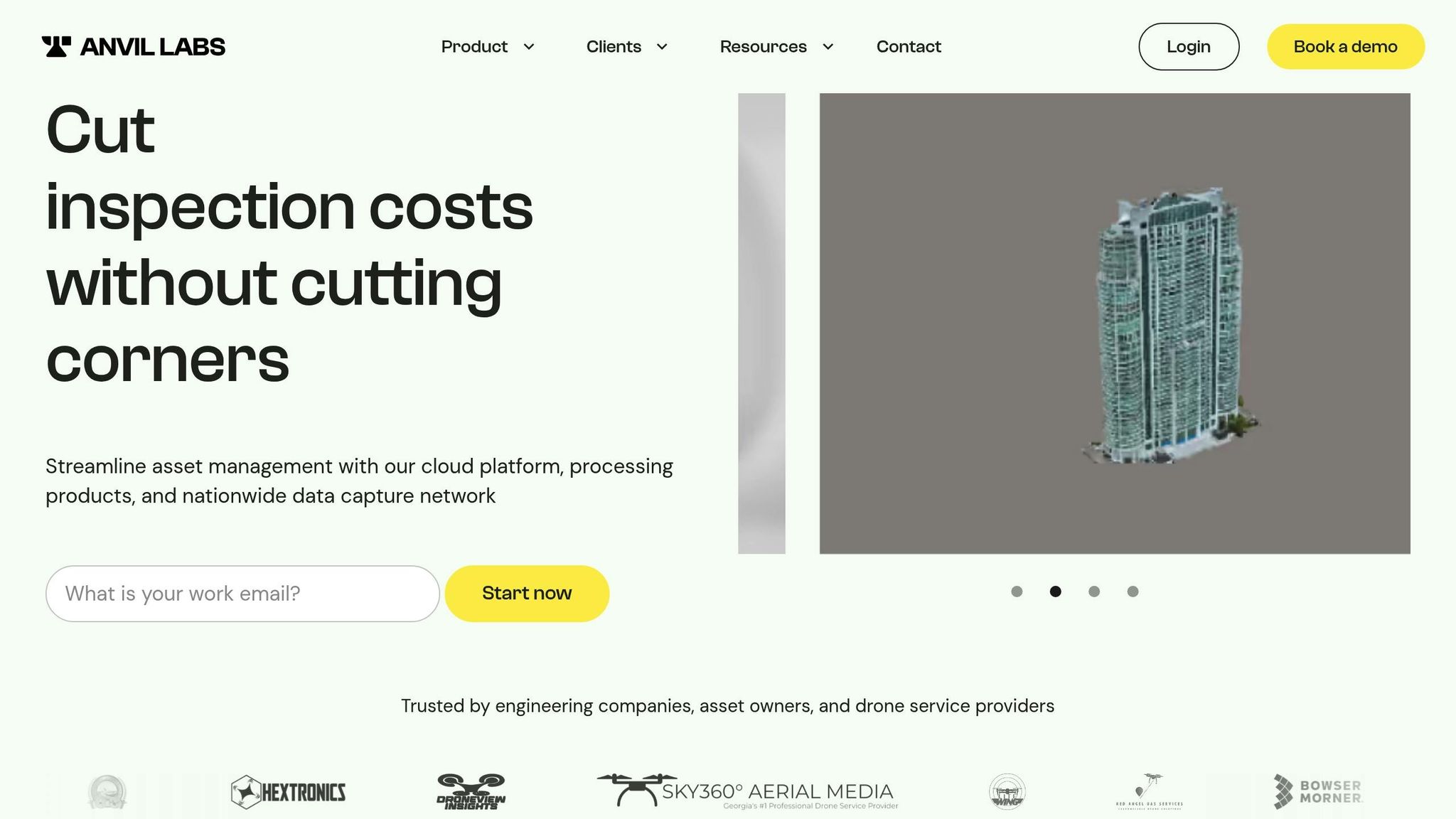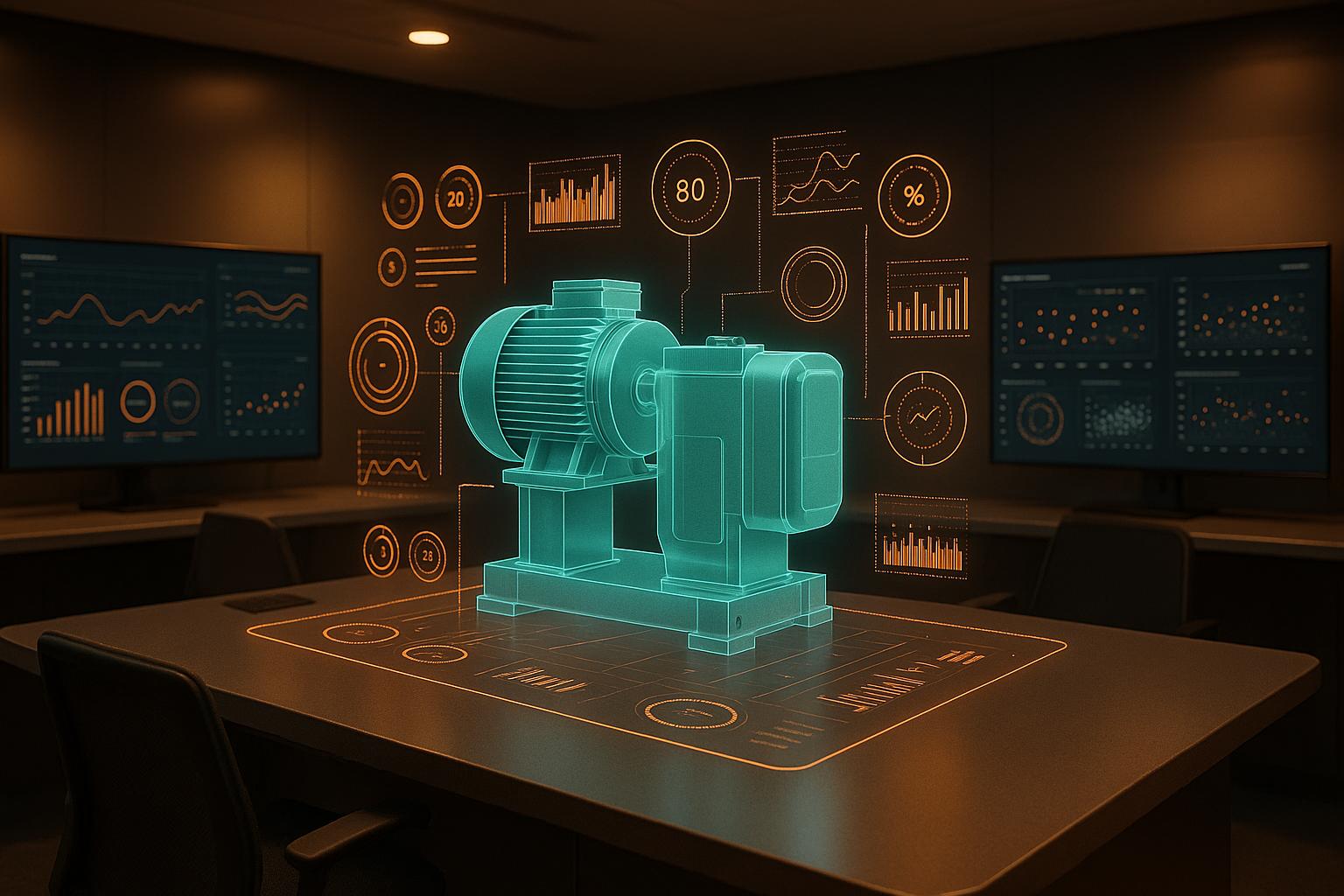Digital twins are reshaping how industries manage assets by combining virtual models with real-time sensor data. These digital replicas provide insights into equipment performance, helping predict failures and reduce downtime. Platforms like Anvil Labs stand out by integrating advanced visual data - such as thermal imagery, LiDAR, and 360° panoramas - into a single system, simplifying analysis and improving maintenance planning.
Key takeaways:
- Predictive Maintenance: Digital twins use sensor data to identify issues before failures occur.
- Advanced Visualization: Tools like 3D models and thermal imagery enhance monitoring.
- Cloud-Based Platforms: Enable secure, scalable, and remote data access.
- Anvil Labs Pricing: $49/project or $99/month for asset management.
Anvil Labs excels in handling complex sensor data with user-friendly tools and predictable pricing, making it a strong choice for industries managing large-scale operations.
Predictive Maintenance: Getting the most out of your Digital Twin
1. Anvil Labs

Anvil Labs has carved out a niche in the digital twin landscape with its expertise in integrating sensor data. Their platform offers a sophisticated 3D modeling and spatial analysis solution tailored for industrial management. What sets it apart is its ability to handle a variety of critical data types, including 3D models, 360° photos, thermal imagery, LiDAR point clouds, and orthomosaics - all essential for building effective digital twin systems.
Sensor Data Support
This platform shines when it comes to managing diverse sensor data formats, a key feature for predictive maintenance. By processing thermal imagery and LiDAR data, it can deliver highly accurate spatial measurements and pinpoint temperature irregularities.
What’s more, the platform combines traditional visual data with cutting-edge sensor technologies. For example, 360° panoramic views provide comprehensive visual context, while orthomosaic hosting overlays sensor readings onto precise aerial imagery. This layered approach ensures that sensor data is not only collected but also presented in a meaningful spatial framework.
Integration Capabilities
Anvil Labs takes integration to the next level by connecting with tools like Matterport, YouTube, AI analysis platforms, and task management systems. This seamless integration helps streamline workflows, making it easier to manage digital twin projects.
The platform also supports cross-device accessibility and offers secure sharing with access control, enabling smooth collaboration across teams and even with external stakeholders. These features make it possible to deploy digital twins at scale while keeping costs manageable.
Cost and Scalability
Anvil Labs provides two pricing options to suit different needs:
- The Asset Viewer plan costs $99 per month and includes hosting, management, and collaboration tools for multiple projects.
- The Project Hosting plan is priced at $49 per project, offering secure storage and collaboration features for individual initiatives.
Additionally, optional data processing services are available at $3 per gigapixel, giving organizations the flexibility to scale their data processing as needed. This pricing model allows businesses to start small and expand over time as their digital twin projects grow. With its cloud-based design, the platform eliminates the need for heavy upfront hardware investments, making advanced digital twin tools accessible to companies of all sizes.
Next, we’ll explore other cloud-based digital twin platforms to compare their integration capabilities.
2. Other Cloud-Based Digital Twin Platforms
The digital twin market is growing quickly, with a variety of cloud-based platforms offering different methods for handling sensor data. Each platform brings its own strengths, particularly in predictive maintenance. Here's a closer look at how these platforms handle sensor data integration compared to Anvil Labs.
Sensor Data Support
Most platforms handle standard IoT data like temperature, vibration, and pressure efficiently, using well-established protocols. However, support for more complex data types, such as thermal imagery or LiDAR point clouds, is less common. While some platforms are starting to integrate computer vision for analyzing camera feeds, this often requires additional software or third-party tools. In contrast, Anvil Labs stands out by seamlessly incorporating these advanced visual formats into its system.
Integration Capabilities
Many platforms offer an array of APIs and pre-built connectors to integrate with systems like enterprise resource planning (ERP), manufacturing execution systems (MES), and computerized maintenance management systems (CMMS). Edge computing is also a common feature, enabling local data processing to reduce bandwidth needs and improve response times. Hybrid models - combining on-site processing with cloud-based analytics - are widely used, though maintaining consistent data standards across multiple systems can be a significant hurdle. Anvil Labs differentiates itself by offering seamless integration and smooth cross-device functionality.
AI and Predictive Analytics
Machine learning is a key feature across most platforms, helping to detect anomalies, predict equipment failures, and optimize maintenance schedules. These predictive models rely heavily on high-quality sensors and extensive historical data. They often take several months to become fully reliable, similar to Anvil Labs' approach to delivering actionable insights. The focus is typically on estimating the remaining useful life of equipment and identifying failure probabilities to streamline maintenance planning.
Cost and Scalability
Most platforms follow a subscription-based pricing model, with costs tied to the number of connected assets or the volume of data processed. While initial setup expenses can be high, the cost per asset decreases as organizations scale up their deployments. Larger implementations particularly benefit from this model, as adding new assets incurs only minimal additional costs. However, companies should be mindful of potential data egress fees when exporting large amounts of sensor data for external analysis.
sbb-itb-ac6e058
Platform Advantages and Disadvantages
When it comes to choosing a digital twin platform for sensor data integration, weighing the pros and cons of different solutions is essential. Below is a comparison of the features offered by Anvil Labs and other cloud-based platforms, summarizing their strengths and potential limitations. This breakdown builds on earlier comparisons to provide a clearer picture of what each option brings to the table.
| Aspect | Anvil Labs | Other Cloud-Based Platforms |
|---|---|---|
| Advantages | • Supports a wide variety of visual data types, including 360° photos, thermal imagery, LiDAR, 3D models, and orthomosaics • Integrated 3D visualization and spatial analysis • Accessible across multiple devices • Includes built-in tools for annotation and measurement • Transparent pricing: $49/project for hosting and $99/month for the Asset Viewer plan |
• Tailored for large-scale enterprise integration • Established solutions for industrial-level deployments |
| Disadvantages | • No specific disadvantages noted | • Can involve complex setups with longer learning curves due to advanced integrations |
Sensor Data Handling
Anvil Labs excels in handling complex visual data types by consolidating inputs from multiple sensors into a single platform, simplifying analysis. On the other hand, some competing platforms may require additional integration efforts to process similar data types effectively.
Integration Complexity
While many established platforms offer extensive enterprise connectivity, this often comes with added configuration requirements. Anvil Labs, however, stands out with its user-friendly interface, enabling seamless integration and quick deployment.
Cost Structures
Pricing models vary across digital twin platforms. Anvil Labs offers straightforward pricing options, such as $49 per project for hosting and $99 per month for its Asset Viewer plan, making it easier to budget for maintenance and operations. Other platforms may follow subscription models tied to asset count or data usage, which can make costs less predictable.
Predictive Maintenance Effectiveness
For predictive maintenance, the ability to integrate sensor data effectively is crucial. Platforms that handle diverse sensor inputs, including advanced visual data, improve anomaly detection and monitoring. Anvil Labs' emphasis on integrated visual data capabilities supports these needs, making it a strong choice for maintenance-focused applications.
Implementation Speed
The speed of implementation can significantly impact operations. Thanks to its intuitive interface, Anvil Labs simplifies the setup process, allowing organizations to get started quickly. In contrast, more complex platforms may require longer onboarding times due to their advanced configurations.
Ultimately, the right platform will depend on specific operational requirements, the systems already in place, and the organization’s broader digital twin goals.
Conclusion
Digital twin platforms vary significantly in how they handle sensor data integration, and this difference can directly influence predictive maintenance and the management of industrial sites. Among these platforms, Anvil Labs stands out for its ability to merge visual data seamlessly and its user-friendly setup, making it a solid choice for overseeing complex industrial environments.
Anvil Labs brings together visual sensor inputs like thermal imagery, LiDAR, and 360° panoramas into a single, unified platform. This consolidation is a game-changer for monitoring large-scale facilities. Plus, with its cross-device accessibility, maintenance teams can access vital data from the field or a control center without missing a beat.
When it comes to predictive maintenance, Anvil Labs combines thermal imagery, 3D modeling, and built-in annotation tools to create detailed, actionable maintenance records. These features not only enhance operational oversight but also simplify decision-making.
Another advantage is its straightforward pricing structure. With hosting costs set at $49 per project and the Asset Viewer plan priced at $99 per month, Anvil Labs provides clear and predictable budgeting for businesses investing in digital twin technology.
Its intuitive interface also speeds up deployment and reduces the learning curve, which is crucial for organizations eager to see immediate benefits from predictive maintenance.
In short, Anvil Labs delivers practical solutions for sensor data integration, making it an effective tool for asset monitoring and proactive maintenance strategies.
FAQs
How do thermal imagery and LiDAR data improve predictive maintenance in digital twins?
Integrating thermal imagery and LiDAR data into digital twins offers a more detailed, real-time perspective on equipment and environments, making predictive maintenance smarter and more effective. Thermal imagery is particularly useful for spotting heat anomalies, like overheating components, which often serve as early warning signs of potential failures. At the same time, LiDAR creates highly accurate 3D models, allowing for precise monitoring of structural integrity and spatial conditions.
Together, these technologies enable early issue detection, improved equipment performance forecasting, and streamlined maintenance scheduling. This means digital twins can help industrial operations run more reliably while cutting down on costly downtime.
What are the main advantages of using a cloud-based platform like Anvil Labs for managing digital twins and sensor data?
Using a cloud-based platform like Anvil Labs to handle digital twins and sensor data brings several advantages, including the ability to scale, adaptability, and real-time data processing. These features make it easier for businesses to store massive amounts of data, access essential information from virtually anywhere, and run advanced simulations or predictive maintenance without a hitch.
When sensor data is integrated with digital twins, the platform boosts operational efficiency, aids in smarter decision-making, and refines maintenance planning. This streamlined approach allows organizations to manage industrial assets more effectively, ensuring they remain agile and competitive in a fast-paced market.
How does Anvil Labs provide secure and scalable access to sensor data for teams across multiple devices?
Anvil Labs prioritizes both security and scalability when it comes to handling sensor data. By using encrypted data storage and enforcing strict access controls, the platform ensures that sensitive information remains protected. Access to this data is tightly regulated, allowing only authorized users to retrieve and work with it.
Built on a cloud-based infrastructure, the platform is designed to scale effortlessly. Teams can collaborate across multiple devices without worrying about performance or security issues. This setup enables smooth data sharing and analysis, even for large-scale projects, while adhering to rigorous data protection standards.

